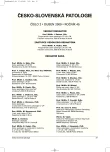Our Experience in Using Fluorescence in situ Hybridization FISH-Uro Vysion in Diagnostics of Urothelial Carcinoma
Authors:
V. Vít 1; D. Pacík 1; A. Čermák 1; I. Falková 2; J. Šmardová 2; R. Hrabálková 2; M. Svitáková 2; Z. Pavlovský 2; M. Votava 2
Authors‘ workplace:
Urologická klinika FN a LF MU, Brno
1; Ústav patologie FN a LF MU, Brno
2
Published in:
Čes.-slov. Patol., 45, 2009, No. 2, p. 46-49
Category:
Original Article
Overview
Urothelial carcinoma is a disease at high risk of recurrence after the initial therapy (70-80 %) and with the tendency to progression accomplishing the recurrence (30 %). Long lasting monitoring of patients with urothelial carcinoma is necessary. Cystoscopy and cytology are currently the primary modalities used to detect and monitor urothelial carcinoma. However, cytology has relatively poor sensitivity especially in well differentiated tumors. Cystoscopy is an invasive and relatively expensive method. Therefore, methods improving detection of urothelial carcinoma from urine specimens are employed. Uro Vysion (Vysis) fluorescence in situ hybridization (FISH) for improved detection of urothelial carcinoma was evaluated.
Materials and methods:
Bladder tumor progression is accompanied by increased chromosomal instability and aneuploidy of chromosomes 3, 7, 17 and loss of locus 9p21. A total of 124 patients were analyzed at Dpts. of Urology and Pathology, Faculty Hospital in Brno. Cytologically analyzed urine specimens were tested by FISH and simultaneously cystoscopy was employed including biopsy for histological examination.
Results:
FISH analysis was positive in 35 cases, including 5 cases with negative biopsy and cytology. Negative FISH result was detected in 24 cases where the malignant status was determined. The sensitivity of FISH in our series was 58.9 % and the specificity 88.1 %.
Conclusions:
FISH is a relatively simple, speedy and non invasive diagnostic method. It detects the symptoms of malignity on the molecular level, which leads to earlier diagnosis and therapy and, hence, to potential extended survival. FISH makes it possible to take decision in cases of atypical or unclear cytological finding. The FISH method using the Uro Vysion kit appears as a prospective non invasive method capable of early UK detection, with a higher sensitivity than the standard cytology of urine.
Key words:
urothelial carcinoma – chromosomal abnormalities – cytology – fluorescence in situ hybridization – histology
Sources
1. Halling, K.C., King, W., Sokolova, I.A. et al.: A comparison of cytology and fluorescence in situ hybridization for the detection of urothelial carcinoma. J. Urol. 164, 2000, s. 1768–1775.
2. Kipp, B.R., Karies, R.J., Brankley, S.M. et al.: Monitoring intravesical therapy for superficial bladder cancer using fluorescence in situ hybridization. J. Urol. 173, 2005, s. 401–404.
3. Kruger, S., Mess, F., Bohle, A. et al.: Numerical aberrations of chromosome 17 and the 9p21 locus are independent predictors of tumor recurrence in non-invasive transitional cell carcinoma of the urinary bladder. Int. J. Oncol. 23, 2003, s. 41–48.
4. Kurth, K.H., Bouffioux, C., Sylvester, R. et al.: Treatment of superficial bladder tumors. Achievements and needs. Eur. Urol. 37(Suppl 3), 2000, s. 1–9.
5. Lukášova, E., Kozubek, S., Falk, M. et al.: Topography of genetic loci in the nuclei of cells of colorectal carcinoma and adjacent tissue of colonic epithelium. Chromosoma 112, 2004, s. 221–230.
6. Mengual, L., Marin-Aguilera, M., Ribal, M.J. et al.: Clinical utility of fluorescent in situ hybridisation for the surveillance of bladder cancer patients treated with Bacillus Calmette-Guérin therapy. European Urology, 52, 2007, s. 752–759.
7. Moonen, P.M.J., Merkx, G.F.M., Perlen, P. et al.: UroVysion compared with cytology and quantitative cytology in the surveillance of non-muscle-invasive bladder cancer. European Urology, 51, 2007, s. 1275–1280.
8. Sarosdy, M.F., Schellhammer, P., Bílinsky, G. et al.: Clinical evaluation of a multi-target fluorescence in situ hybridization assay for detection of bladder cancer. J. Urol. 168, 2002, s. 1950–1954.
9. Skacel, M., Fahmy, M., Brainard, J.A. et al.: Multi-target fluorescence in situ hybridization assay detects transitional cell carcinoma in the majority of patients with bladder cancer and atypical or negative urine cytology. J. Urol. 169, 2003, s. 2101–2105.
10. Varella-Garcia, M., Akduman, B., Sunpaweravong, P. et al.: The UroVysion fluorescence in situ hybridization assay is an effective tool for monitoring recurrence of bladder cancer. Urol. Oncol.: Seminars and Original Investigations 22, 2004, s. 16–19.
Labels
Anatomical pathology Forensic medical examiner ToxicologyArticle was published in
Czecho-Slovak Pathology

2009 Issue 2
Most read in this issue
- New Trends in Diagnostics and Classification of Breast Carcinoma
- Immunohistochemical Detection of ZAP-70 Protein and its Importance in the Diagnostics of B-CLL
- Our Experience in Using Fluorescence in situ Hybridization FISH-Uro Vysion in Diagnostics of Urothelial Carcinoma
- PAG: A POTENTIAL TUMOUR SUPPRESSOR AND HOW IT ALL STARTED. FROM IMMUNE SIGNALLING TO NEOPLASTIC TRANSFORMATION
